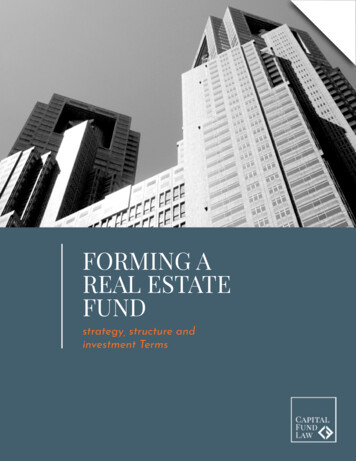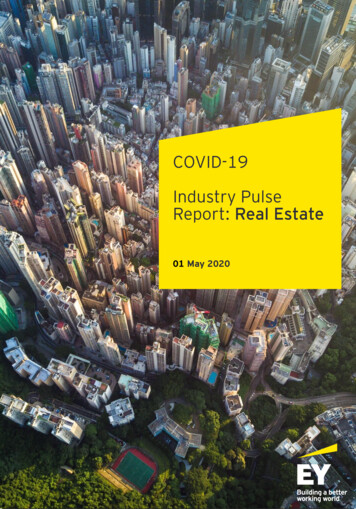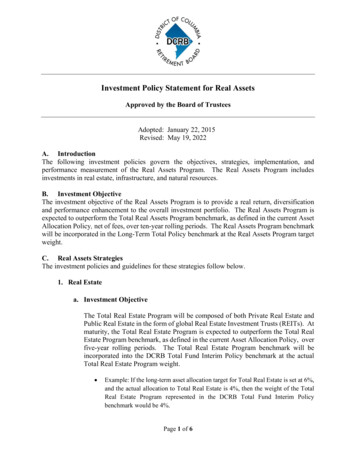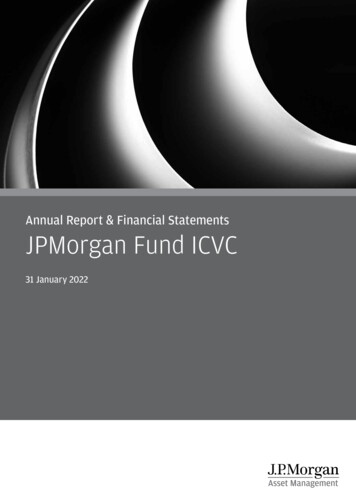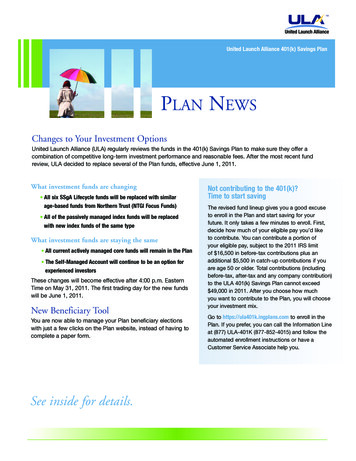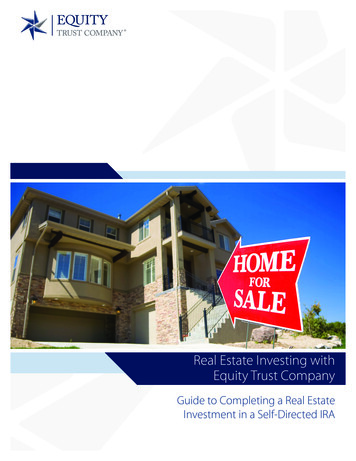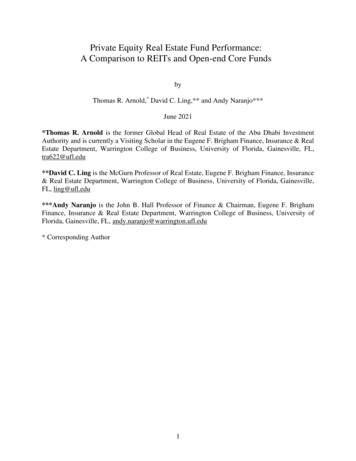
Transcription
Private Equity Real Estate Fund Performance:A Comparison to REITs and Open-end Core FundsbyThomas R. Arnold,* David C. Ling,** and Andy Naranjo***June 2021*Thomas R. Arnold is the former Global Head of Real Estate of the Abu Dhabi InvestmentAuthority and is currently a Visiting Scholar in the Eugene F. Brigham Finance, Insurance & RealEstate Department, Warrington College of Business, University of Florida, Gainesville, FL,tra622@ufl.edu**David C. Ling is the McGurn Professor of Real Estate, Eugene F. Brigham Finance, Insurance& Real Estate Department, Warrington College of Business, University of Florida, Gainesville,FL, ling@ufl.edu***Andy Naranjo is the John B. Hall Professor of Finance & Chairman, Eugene F. BrighamFinance, Insurance & Real Estate Department, Warrington College of Business, University ofFlorida, Gainesville, FL, andy.naranjo@warrington.ufl.edu* Corresponding Author1
Private Equity Real Estate Fund Performance:A Comparison to REITs and Open-end Core FundsJune 2021AbstractWe provide a comprehensive examination of the return performance of closed-end, private equityreal estate (PERE) funds relative to the performance of listed real estate stocks (REITs) and theNCREIF ODCE fund index. We first match each PERE fund in our sample and its realized internalrate of return and equity multiple with the return that would have been earned by an LP investoron an investment in the designated benchmark over each fund’s investment horizon. Overall, wefind that closed-end PERE funds have underperformed listed REITs. In contrast, we find similaroverall performance between PERE and the NCREIF ODCE fund index. We also examine thedeterminants of the relative performance spread between the PERE funds and the equity REITindex and find that the spread widens with interest rate environment variables (Treasury yields anddefault spreads) and narrows with broad macroeconomic performance indicators (growth rate ofGDP).Key Findings1. Closed-end PERE funds underperform listed REITs – both on average and by thepercentages of individual funds.2. The performance spread widens with interest rate environment variables (Treasury yieldsand default spreads) and narrows with broad macroeconomic performance indicators(growth rate of GDP).3. The overall performance between PERE and the NCREIF ODCE fund index is similar.Topics:Return performance, private equity, real estate, open-end core funds, economic environment2
BACKGROUND AND MOTIVATIONPrivate equity real estate (PERE) funds have become an increasingly common mode of accessfor investing in commercial real estate (e.g., Arnold, Ling, and Naranjo, 2019). According toPreqin, the aggregate PERE fund capitalization exceeded 992 billion as of year-end 2019 (Preqin,2020). Preqin predicts the aggregate PERE fund capitalization will exceed 1.2 trillion by 2023. 1Frequently stated advantages of investing in non-listed real estate funds, relative to investingdirectly in private commercial real estate (CRE) as the sole equity investor, include the ability togain portfolio exposure to CRE with less commitment of equity capital, easier implementation ofinvestment strategies compared with direct investment in CRE, potential diversification benefits,and access to expert management. In addition, many investors are attracted to non-listed CREfunds because of their expected high correlation with the underlying CRE market. However, PEREfunds, especially closed-end funds, typically suffer from the same lack of liquidly as directinvestments in CRE. 2The U.S. listed real estate market has grown at an equally fast rate. According to Nareit, themarket capitalization of listed equity REITs was 9 billion at the end of 1991. By year end 2020,this market capitalization had increased to 1.2 trillion. Analogous to PERE, listed CRE providesinvestors the opportunity to increase their portfolio’s exposure to CRE without the burden ofacquiring, managing, and disposing of direct property investments in multiple markets withunfamiliar political and market structures. However, unlike PERE investments, listed CRE stocksprovide investors with a high degree of liquidity and transparency and relatively low transactioncosts. Moreover, shares of listed CRE companies can be purchased in small dollar denominations.We examine the performance of closed-end PERE funds relative to the performance of listedequity REITs and the Open-end Diversified Core Equity (ODCE) index produced by the NationalCouncil of Real Estate Investment Fiduciaries (NCREIF). 3 The NFI-ODCE Index measures the1Over the period 2015 through 2019, the real estate investor universe has grown by over 30%, now with over 7,600institutional investors reporting real estate allocations (Preqin, 2020).2See Arnold, Ling, and Naranjo (2017) for an expanded discussion of the typical life cycle and risks of a closed-endPERE fund.3Established in 1982, NCREIF is a not-for-profit industry association that collects, processes, validates, anddisseminates information on the risk/return characteristics of commercial real estate assets owned by institutional(primarily pension and endowment fund) investors (see www.ncreif.org). The property composition of the NPIchanges quarterly as data contributing NCREIF members buy and sell properties. However, all historical propertylevel data remain in the database and index. NCREIF’s flagship index, the NCREIF Property Index (NPI), tracksproperty-level quarterly returns on a pool of properties acquired in the private market for investment purposes only.3
returns of the largest private real estate funds pursuing a core investment strategy, which istypically characterized by low risk, low leverage, and stable properties diversified across the U.S.We first carefully match the investment horizon of each PERE fund in our sample with thecorresponding investment horizon on the chosen benchmark. This “horse race” approach todetermining the relative performance of PERE is superior to simply comparing an index of PEREreturn performance to a designated benchmark for several reasons. First, the PERE return indicessupplied, for example, by Cambridge Associates and Preqin combine estimated peridoc (e.g.,quarterly) returns for a sample of funds with a range of vintage years. However, our researchclearly shows that PERE performance varies significantly by vintage year; therefore, combiningfunds of different vintages to produce an estimated PERE return in a particular quarter or year canproduce misleading results, especially if the researcher is unaware of how the mix of funds in thereported index varies over time. A second advantage of our approach is that it allows us todetermine the perentage of funds that outperform a selected benchmark over their investmenthorizon. With the matched set, we calculate the unconditional (mean and median) returnperformance differences of the matched sample. We also examine the determinants of the relativeperformance between the PERE funds and the equity REIT index we use for comparison. Althoughseveral papers have examined dimensions of PERE performance, 4 to our knowledge no researchhas examined the performance of individual PERE funds relative to listed equity REITs andrelative to the NCREIF ODCE Index using fund-level data.DATATotal returns of non-listed CRE assets, such as PERE funds, which are typically reported on aquarter-to-quarter basis, suffer from potentially severe measurement problems. In particular, evenif periodic cash investments and cash flow distributions to investors are available, quarter-toquarter changes in the value of the fund’s assets are estimated by the manager or, occasionally, byan independent fee appraiser at intermittent intervals (e.g., one to three years). The reliance onestimated quarterly valuations rather than transaction prices is well known to produce lagging andsmoothing in the reported quarter-by-quarter capital appreciation reported by the manager;4See, for example, Hahn et. al, 2005; Tomperi, 2010; Bond and Mitchell, 2010; Alcock et al., 2013; Fisher andHartzell, 2016, Delfim and Hoesli, 2016, Bollinger and Pagliari, 2019, Gupta and Van Nieuwerburgh, 2021, andRiddiough, 2021. See Riddiough and Wiley (2021) for a comparison of the performance of PERE to unlisted REITs.4
therefore, estimated total returns suffer from serial correlation over time. 5 We mitigate this interimmeasurement problem by comparing holding periods returns and equity multiples measured overthe life of the PERE fund.The source of our PERE data is Cambridge Associates (CA). CA’s PERE dataset containsinformation on 950 distinct PERE funds, enabling the most exhaustive investigation of theirperformance to date. The time frame examined is 2000Q1 through 2019Q4, or eighty (80) quarters.The information provided by CA includes the fund name, the year of legal inception (what werefer to as “vintage”), fund size in U.S. dollars (which are aggregate investor commitments, knownas assets under management, or “AUM”), and the quarter during which each fund’s capital was atleast 25%, 50%, and 75% called from its limited partners by the general partner.Additionally, CA provides performance metrics for each quarter including the net, to-date,internal rate of return (IRR) projected to be earned by LPs and the projected LP equity multiple(EM), defined as the total amount of cash expected to be distributed to LPs, divided by the totalamount of equity invested by the LPs. This information is available beginning the later of Q1 2000,or the first quarter the fund began reporting to CA. The performance metrics are available for thelessor of 80 quarters or the number of quarters reported by the manager based on the vintage andlife of the fund. CA also classifies each fund as fully “liquidated,” “still active,” or indicates themanager has “stopped reporting.” The IRR and EM reported to CA by each manager are quitespeculative early in each fund’s life given limited capital deployment, uncertain performance, andfew, if any, cash flow distributions to investors. The reported IRR and EM become morerepresentative of each investor’s actual experience through the passage of time.CA also provides limited information on the geographic target of a fund’s investment.Typically, funds are identified as predominantly U.S. (domestically) focused, internationallyfocused, or in a few instances, a non-U.S. country or region of focus. CA also indicates whetherthe fund’s initial investment mandate was core, core-plus, value-added, development,opportunistic, or distressed debt.CA receives fund performance data directly from the manager, but validates much of thisreporting with fund investors. CA does not make individual fund information publicly availableunless a manager is in the market raising a new fund or the manager provides CA permission to5For a discussion of the lagging and smoothing inherent in appraisal-based property valuations, see Fisher and Geltner(2000) and Geltner and Ling (2007) and references therein.5
“unlock” their fund data to an identified data subscriber. The confidentiality provided to managershelps to mitigate reporting bias, and there appears to be no selection bias in that CA requestsinformation from any PERE fund of which it is aware. Importantly, once a manager’s performancedata has been obtained, it remains in the database even if the sponsor of the fund suspendsreporting.The comprehensive 950 fund sample provided by CA includes funds sponsored by 290managers, with 780.6 billion of assets under management (AUM) (see Exhibit 1). We manuallyexclude 123 funds identified as private debt funds, homebuilder lot acquisition or developmentfunds, infrastructure funds, or health care funds because they are less representative of commercialor multifamily residential real estate exposures. 6 We exclude 61 the funds with vintages from 1987to 1999 because CA did not provide performance data prior to 2000. These deletions produce apreliminary sample of 766 PERE funds with AUM of 624.5 billion, of which 465 funds areidentified as primarily U.S. focused. CA classifies 301 funds as internationally focused.(Exhibit 1 here)At year-end 2019, CA reported that only 216 of the 950 PERE funds were “liquidated.” Theremainder were classified as “active,” possibly creating a small number of final (liquidated)observations for analysis. We do not to rely on a “fully liquidated” designation from CA to includethe fund in our analysis because we believe many funds are economically dormant before beingdesignated as fully liquidated by CA and should therefore be included in our sample. Numerousprivate equity researchers follow a “seasoned fund” approach to sample selection that assumes thatif a fund is at least four or five years old, the performance metrics reported by CA or other dataproviders can be considered final (e.g., Harris, Jenkinson, & Kaplan, 2014). Following thisseasoned fund sampling approach, the exclusion of funds that came to the market after 2014 furtherreduces our sample by 129 funds. After removing six funds with missing data and one fund whosereported IRR was zero, our seasoned fund approach produces a sample of 630 PERE funds withAUM of 480.0 billion. Of these, 375 are identified by CA as funds that invest primarily in theU.S; 255 funds are classified as international PERE funds.6We distinguish between private debt funds, excluded bond-like investments for our analysis, and non-performingloan funds, included in our analysis. Non-performing loan funds are often a high-risk mode of access to real estateinvestments through foreclosure proceedings or voluntary deed-in-lieu of foreclosure transfer from debtor to creditor.6
For a variety of reasons, including potential fund manager final timing manipulation, it is likelythat some funds with a vintage year of 2014 or earlier are economically alive and therefore notreporting final performance metrics. 7 To investigate this final fund sample selection issue, wedevelop an additional algorithm to establish whether each fund’s reported IRR is effectively finaland therefore should be included in an alternative “economic fund life” sample that we use for aseries of additional robustness tests. Our algorithm is based on the assumption that, if the reportedIRR remains constant, or nearly so, for a sufficient number of quarters, the fund’s reported IRR isfinal, even if not designated so by CA. Funds often maintain accounts and sometimes reserves fora number of years after the cash flow distributions, and therefore their returns, are largely finalized.For example, reserves may be held as a cushion against a future lawsuit or some other unexpectedevent that will require a cash outlay. In such situations, the fund may be economically completelong before it is fully liquidated from a legal perspective.Our additional economic fund life sampling approach starts with the 766-fund sample thatexcludes non-CRE funds and funds with vintage years prior to 2000 (top panel of Exhibit 1). Asin the seasoned fund sampling approach, we delete 129 funds with vintage years after 2014 as wellas 19 funds that have called less than 50% of committed LP capital and 28 funds that were inexistence for less than 20 quarters. Next our algorithm scans the quarterly IRR reported by eachremaining fund and determines whether the reported fund IRR remains unsettled or is effectivelystable using three related criteria. First, is the variation in the reported IRR over a predeterminednumber (N) of consecutive quarters within a tolerable, immaterial range? Second, for how manyconsecutive quarters must the reported IRR exhibit variation within the acceptable range beforewe designate the fund as economically final. Finally, is an acceptable variation in IRR over Nconsecutive quarters measured in terms of a simple average of the absolute value of the variationfrom the mean over the N quarters, or measured as the exponential average of the absolute valueof the variation over the N quarters?We tested an IRR tolerance of five to 50 basis points in five basis point increments over aperiod of one to eight quarters in single quarter increments. Ultimately, we decided that if a funddoes not report an average absolute change in IRR of more than 15 basis points over six7Given a sufficient period of hindsight, researchers can ex-post establish whether a performance metric reported in aparticular quarter is stable and therefore final. The challenge, without the benefit of hindsight, is to estimate wheninterim reporting becomes final.7
consecutive quarters, the IRR reported at the beginning of the six quarters is used as the fund’sfinal IRR, regardless of CA’s categorization or its vintage year. We also visually inspected eachfund’s reported IRR from quarter-to-quarter to determine if our algorithm does an acceptable jobof identifying when a reported IRR is, effectively, final. This final sample selection criteriaremoved an additional 247 funds, which resulted in much more restrictive sample of 342 PEREfunds with AUM of 241.1 billion, of which 211 (131) funds are identified as U.S. (international)funds. We use this significantly reduced economic fund life sample for a restricted number of fundsample selection robustness checks.Summary StatisticsAs Exhibit 2 illustrates, the mean IRRs on the fund and the corresponding returns on the FTSEEPRA/NAREIT U.S. Net Total Return Index for the seasoned fund sample are 8.69% and 10.34%,respectively. Thus, the sample of 375 domestic funds underperformed the REIT index by anaverage of 165 basis points annually. The corresponding fund and equity REIT median returns onthe domestic equity REIT index are 10.71% and 10.58%, respectively. Thus, based on medians,the seasoned fund sample outperformed the corresponding median return on the equity REIT indexby 13 basis points. The large differences in mean and median fund IRRs indicates that returnperformance is highly skewed to the left in our seasoned fund sample.(Exhibit 2 here)In contrast, the equally weighted mean IRR of the 211 domestic funds in the economic fundlife sample is 8.12%. The corresponding mean return on the domestic equity REIT index is 9.98%.Thus, these 211 funds underperformed the REIT index by an average of 186 basis points annually.This is 21 basis point greater than the mean underperformance of the funds in the larger, lessrestrictive, seasoned fund sample. The equally weighted median IRR of the 211 domestic funds is8.63%; the median return on the REIT index is 10.30%. Thus, based on medians, the sample of211 funds underperformed REITs by 167 basis points.While both the seasoned fund and economic fund life samples show significant fundunderperformance on average (i.e., 165 bp and 187 bp average underperformance, respectively),the two sampling approaches do show variation in their average fund performances. The equallyweighted mean of the economic fund life sample is 57 basis points lower (8.12% versus 8.69%)than the mean of the seasoned fund and the median of the more restrictive sample is dramaticallylower (8.63% versus 10.71%). This suggests that our algorithm’s exclusion of the additional 1648
U.S. funds (375 less 211) removes funds averaging IRRs of 9.42%, or 130 basis points greaterthan the funds determined by our algorithm to be final. 8The equally weighted mean EM of the 375 domestic funds in the seasoned fund sample is 1.38.The corresponding EM on the domestic equity REIT index is 1.61. Thus, the mean EM fordomestic funds is 0.23 less than the mean EM that would have been earned on an investment inthe equity REIT index. Among the 211 funds in the more restrictive sample, the mean EM of 1.38is 0.33 less than the mean REIT EM.Panel A of Exhibit 3 displays the vintage year variation of PERE activity by fund count for the630 funds in our seasoned fund sample; panel B displays the vintage year variation of the 342funds in our economic fund life sample. PERE fund raising activity increased steadily from 2001through 2007. Over this period, the average fund size increased from approximately 400 millionAUM to over 900 million AUM. However, the number of funds coming to market droppedsharply with the onset of the global financial crisis, as did average fund size. Fund raising activityand average fund size generally increased from 2011 through 2014. As expected, a year-by-yearcomparison of Panel A and Panel B reveals that the number of funds in our economic fund lifesample is always less than the seasoned fund sample; these differences are notably significant after2009.(Exhibit 3 here)Performance by Fund CharacteristicsExhibit 4 displays vintage year variation in the performance of U.S. PERE for the seasonedfund sampling approach. Panel A depicts the equally weighted IRR average for U.S. funds, whilePanel B depicts the mean IRRs for international funds. We observe large variation in IRRs acrossvintage years. For example, the mean IRR of U.S. funds exceeded 20% in 2001 but fell to -5.58%among funds brought to market in 2005. This deterioration in performance was likely caused bycapital being deployed by fund managers during the boom in CRE prices that occurred just priorto the significant CRE pricing downturn that began in most parts of the U.S. in late 2007 or 2008(Chervachidze and Wheaton, 2013; Duca and Ling, 2020). The mean IRR, however, jumped to6.44% in 2007, to 15.19% in 2008 and to 16.76% in 2009. This sharp rise in reported performance89.42% is calculated by solving the following expression for R: 8.69% x (375/375) [(211/375) x 8.12%] [(164/375)x R].9
reflects the timing of capital raising and investment by funds with 2007, 2008, and 2009 vintageyears; these funds had the discretionary capital needed to deploy funds at a time when bothproperty prices, liquidity, and investor appetite for CRE had fallen dramatically. After purchasingproperties in distressed (or at least “stressed”) markets, these fund managers benefited from theeventual recovery in CRE markets. Mean IRRs ranged from 9.93% to 14.68% for funds withvintage years of 2010-2014. The time-series pattern for funds with international exposures (PanelB) is similar, but more volatile. Overall, the large variation in reported IRRs across vintage yearsdisplayed in Exhibit 4 suggests that economic cycles and the macroeconomic variables that drivethese cycles are important determinants of fund performance.(Exhibit 4 here)Exhibit 5 provides equally weighted descriptive statistics for final IRRs and equity multiplesfor our seasoned fund sample disaggregated by fund risk profile, manager type, fund size, and preor post-2006 vintage. The mean IRR for the 132 high risk funds is 7.74%; the corresponding meanIRR for the 243 lower risk funds (core, core-plus, and value-added) is 9.21%. This 147 basis-pointdifferential is consistent with the findings of Pagliari (2017), Fisher and Hartzell (2016), andArnold, Ling, and Naranjo (2019). The median IRR for higher risk funds is 39 basis points lowerthan the corresponding return for low risk funds. The mean IRRs are substantially lower than thecorresponding means, which further indicates that fund performance is skewed to the left. Themean equity multiple produced by high-risk funds is 0.05 lower than the multiple produced bylower risk funds; the median high-risk equity multiple is 0.03 lower. Only the top quartile highrisk funds outperformed their respective quartile of low risk funds, albeit marginally with a 0.10%IRR difference.(Exhibit 5 here)The managers of 327 funds (87%) in our seasoned fund life sample are private entities; 48funds are managed by affiliates of publicly-traded entities. The mean (median) IRR for privatemanagers is 9.01 (10.54%); the mean (median) IRR for funds managed by publicly-traded entitiesis 6.50% (10.82%). However, the volatility of LP returns with private managers is slightly higher,as evidenced by the 25th and 75th percentile IRRs. The mean (median) equity multiple producedby private managers is 0.03 greater than public managers; the median is 0.07 higher.Arnold, Ling, and Naranjo (2019) find that fund size is positively associated with performance,although this relationship is stronger for funds with an exposure to international properties. We10
define large (small) funds as being above (below) the sample median. The mean IRR for largefunds in our domestic seasoned fund sample is 8.36%; the corresponding mean IRR for small fundsis 8.98%. While this 62 basis-point differential might appear inconsistent with the earlier findingsin Arnold, Ling, and Naranjo (2019), the performance comparison of large funds versus smallfunds in that prior study was conducted on a value weighted basis whereas the performance metricsreported in Exhibit 5 are equally weighted. This suggests that smaller funds outperform large fundson average, but the mega-funds running the largest AUMs dominate both small and large funds.The median IRR for large funds is 152 basis points lower than the corresponding return for lowrisk funds. The mean equity multiple produced by large funds is 0.10 lower than the small fundmultiple.The mean (median) IRR for the 267 funds in our domestic sample that came to market in 2006or afterwards is 10.70 (11.66%). In contrast, the mean (median) IRR for funds with vintage yearsprior to 2006 is 3.73% (3.01). These large differences reflect the poor performance of many closedend PERE funds that came to market in the years immediately preceding the financial crisis.THE RELATIVE PERFORMANCE OF PEREComparing PERE and Equity REIT ReturnsOur research methodology is similar in spirit to the use of a private market equivalent (PME)as a benchmark to evaluate the performance of a private equity fund. The PME, a performancemetric developed by Kaplan and Schoar (2005), compares the return a fund investor earned net offees to what that same investor would have earned in equivalently timed investments in anappropriate public market index. However, calculation of the PME requires data on all limitedpartner capital investments (calls) and cash flow distributions over the life of the fund. Such dataare not available to us from Cambridge Associates.Our stylized PME approach uses the quarter that a fund becomes 50% called and the effectiveduration in quarters of the invested capital, which we derive from the mathematical equivalencyof the net IRR and net equity multiple. This stylization allows us to covert each fund’s multiplecapital inflows and outflows into a single inflow and single outflow, over a defined investmenthorizon, and compare that same investment in an index over the equivalent time horizon. Sincethe actual fund IRR and equity multiple provided by Cambridge Associates is a dollar-weightedcalculation, the conversion of the cash flows to a single inflow and single outflow allowscomparability of the fund’s returns to the time-weighted returns of a benchmark index. See the11
Appendix for an explanation of how we determine the duration of the fund’s life and an analysisof the robustness of our methodology.Adjusting for the Relative Risk of PERERelative to equity REITs, the typical closed-end PERE fund is significantly less liquid, usesmore financial leverage, and requires investors (LPs) to maintain liquid assets (“dry powder”) forcapital calls of indeterminate size and timing. Research in listed stock markets consistently findsa significant positive return premium for stock illiquidity (Amihud et al., 2015; Chaieb et al.,2020), although estimates of an appropriate ex ante illiquidity premium vary widely with theestimation methodology, sample period, and sample selection. Moreover, even the most illiquidlisted stocks are more liquid than closed-end PERE funds. Sorensen et al. (2014) find that the costof illiquidity in the broader private equity market is comparable to the cost of the GP’s totalcompensation. We therefore believe that a 200 basis point upward adjustment to the annualizedIRR earned on each fund’s REIT benchmark is a conservative adjustment for the illiquidity ofPERE funds relative to liquid REITs.Over the 2000 to 2018 period, the use of financial leverage boosted equity REIT returns by anaverage of over 3.0 percentage points annually (Ling and Naranjo, 2015). During this period, thetypical equity REIT employed about 35-40% leverage. Although the leverage employed by closedend PERE funds is not readily observable, we estimate the typical fund in our sample employed60-70% leverage based on industry sources and inspection of private placement memorandums. A100 basis point upward adjustment to the annualized IRR earned on each fund’s REIT benchmarkis a conservative adjustment for the greater use of leverage by PERE funds.Unlike investors in open-end PERE funds, LP investors in closed-end funds incur anopportunity cost associated with maintaining sufficient liquidity in their portfolio to cover capitalcalls by the fund manager of uncertain magnitude and timing. This opportunity cost, which isignored in industry calculations of IRR, is time-varying and unique to each investor. It may alsovary for the same investor under different circumstances (i.e., market conditions, alternativesources of liquidity, the relative maturity of the PERE investment program). Since the opportunitycost of keeping dry powder is difficult to estimate ex ante and varies with the circumstances andrisk aversion of the investor, Arnold, Ling, and Naranjo (2017) propose the use of a range of costs.We initially adjust upward the annualized IRR earned on each fund’s REIT benchmark by 12512
basis points (annually), which is on the low end of the estimates provided by Arnold, Ling, andNaranjo (2017), to account for this opportunity cost of maintaining dry powder. In our comparisonsof PERE performance to listed REITs, we therefore argue that annual IRR adjustments forilliquidity, financial leverage, and the opportunity cost of waiting of at least 425 basis points isreasonable.However, arguments can be made
Private equity real estate (PERE) funds have become an increasingly common mode of access for investing in commercial real estate (e.g., Arnold. According to , Ling, and Naranjo, 2019) Preqin, the aggregate PERE fund capitalization exceeded 992 billion as of year-end 2019 (Preqin, 2020).

